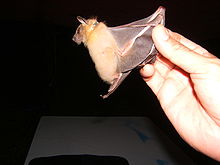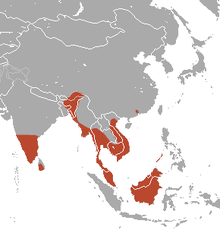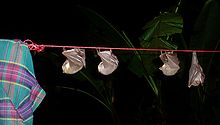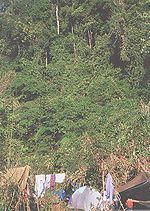- Lesser Short-nosed Fruit Bat
-
Lesser Short-nosed Fruit Bat 
Lesser Short-nosed Fruit Bat Conservation status Scientific classification Kingdom: Animalia Phylum: Chordata Class: Mammalia Order: Chiroptera Family: Pteropodidae Genus: Cynopterus Species: C. brachyotis Binomial name Cynopterus brachyotis
(Müller, 1838)
Lesser Short-nosed Fruit Bat range The Lesser Short-nosed Fruit Bat (Cynopterus brachyotis) is a species of megabat within the Pteropodidae family. It is a small bat that lives in South and Southeast Asia and Indonesia (Borneo) which weighs between 21 and 32 grams (0.74 and 1.1 oz) that occurs in most habitats (but most frequently in disturbed forest) including lower montane forest, tropical lowland rainforest, gardens, mangroves, and vegetation on beaches.[1]
Contents
Description
Lesser Short-nosed Fruit Bats are generally brown to yellowish brown with a brighter collar. Adult males have dark orange collars whereas adult females have yellowish collars. An indistinct collar is observed in some immature bats. The edges of the ears and the wing bones are usually white. Lesser Short-nosed Fruit Bats have two pairs of lower incisors, a fox-like face and large dark eyes.[2] Forearm length is 55-65 mm (2.1-2.6 in), tail length is 8-10 mm (0.3-0.4 in), and ear length is 14-16 mm (0.5-0.6 in) (Payne et al. 1985).
There are nine subspecies of Lesser Short-nosed Fruit Bat.[3] Corbet and Hill listed 19 alternate names of C. brachyotis, which include: Pachysoma brachyotis, P. duvaucelii, P. brevicaudatum, P. luzoniense, C. grandidieri, C. marginatus var. scherzeri, C. marginatus var. ceylonensis, C. marginatus var. philippensis, C. marginatus var. cuminggii, C. marginatus var. andamanensis, C. brachyoma, C. montanoi, C. minutus, C. minor, C. babi, C. archipelagus and C. nusatenggara. Kitchener and Maharadatunkamsi considered luzoniensis and minutus as separate species while Hill and Thonglongya[4] transferred angulatus to C. sphinx.
The lifespan of Lesser Short-nosed Fruit Bats is approximately 20 to 30 years.[5]
Similar species
The Greater Short-nosed Fruit Bat is similar to the Lesser Short-nosed Fruit Bat but has generally longer forearms, longer ears and a much longer skull. P. lucasi has only one pair of lower incisors, a lack of white edges to the ears and a usually greyer color. C.horsfieldi is larger, with heavily cusped molars. M.ecaudatus usually have a more upturned nose, lack a bright collar and tail, and have only one pair of lower incisors.[6]
Diet
Lesser Short-nosed Fruit Bats are frugivorous bats. They prefer aromatic fruit, especially mangoes.[7] The bats feed mainly on small fruits by sucking out the juices and soft pulp. They also eat nectar and pollen.[8]
Reproduction
The mating system of Lesser Short-nosed Fruit Bats is polygynous.[9] In the Philippines, most populations of Lesser Short-nosed Fruit Bats give birth twice a year and pregnant females have been found in almost all months. The period of gestation is approximately 3.5 to 4.0 months. The mother feeds the young with milk for about six to eight weeks. It takes about a year for the male to become sexually mature, and most females become pregnant at approximately six to eight months of age. Medway observed that breeding was non-seasonal in Peninsular Malaysia and that a single young was produced and carried by the female during the early stage of its life. The breeding of Lesser Short-nosed Fruit Bats is also non-seasonal in Thailand, as reported by Lekagul and McNeely (1977). Most pregnancies in Lesser Short-nosed Fruit Bats occur from March to June with peaks in January and September. [10] There is a time regulation in Lesser Short-nosed Fruit Bats so that lactation corresponds with the peak of the rainy season as well as the fruiting season. Both sexes of Lesser Short-nosed Fruit Bats take care of the young. Males play an active role in lactation and feeding the young. They have mammary glands that are same size as the those of the female and exceed 8% of their overall body mass. [11]
Behavior
 Lesser Short-nosed Fruit Bats resting on a clothesline after being released. The white spots on the tops of their heads are hair that was bleached for a "mark-recapture" estimate of the local population size.
Lesser Short-nosed Fruit Bats resting on a clothesline after being released. The white spots on the tops of their heads are hair that was bleached for a "mark-recapture" estimate of the local population size.
Lesser Short-nosed Fruit Bats prefer to roost in small groups in trees, under leaves, and in caves. The roosting of individual Lesser Short-nosed Fruit Bats is either alone for young males or in groups. It is common for one male to roost with four females. Sometimes there may be up to 20 females in groups. [12] Lesser Short-nosed Fruit Bats bite off the center part of palm fruit clusters, leaving a hollow for hanging, which is the method they use to construct a shelter. Males may spend more than two months chewing the veins of leaves and palm fronds until they fall to form a shelter. [13] Lesser Short-nosed Fruit Bats use tactile, visual, and acoustic stimuli to communicate. They forage with their acute sense of smell and navigate with their keen vision. [14]
Distribution and habitat
A Lesser Short-nosed Fruit Bat [15] type specimen was collected from the Dewei River in Borneo on 12 September 1836, and at Naga Cave near Jammut on the Teweh River, Borneo.
Lesser Short-nosed Fruit Bats are widely distributed in Sri Lanka, southwest India, northeast India, Bangladesh, Andaman and Nicobar Islands, southern China, southern Burma, Indochina, Thailand, the Malay Peninsula, Sumatra, Java, Bali, Sulawesi, the Philippines and also on the Lesser Sunda Islands. They are found from sea level up to 1600 m in Borneo.[16][17][18][19][20]They are also reported on several islands including P.Balembangan. The nominate subspecies[21]C. b. brachyotis is distributed in Borneo, Lombok, Peninsular Malaysia, the Philippines and Sulawesi. It is found widespread from sea level to 1,600 meters in altitude[3]. C.b. altitudinis is confined to the highlands of Peninsular Malaysia, from the Cameron Highlands to Gunung Bunga Buah.[3]. C.b. brachysoma is found on the Andaman Islands; C.b. cylonensis in Sri Lanka; C.b. concolor in Enggano; C.b. hoffetti in Vietnam; C.b. insularum on the Kangean Islands; C.b. javanicus on Java; and C.b. minutus on Nias[3]
Ecological and economic importance
Lesser Short-nosed Fruit Bats are free of terrestrial predation because of their ability to fly. Some human cultures consume them as a delicacy. [22] Lesser Short-nosed Fruit Bats play important roles in plant pollination. Plants such as bananas, avocadoes, dates, mangoes, peaches, and agave tequilana depend on them for seed dispersal. Lesser Short-nosed Fruit Bats are considered to be crop pests since they consume and damage fruit. [23]
Conservation status
Lesser Short-nosed Fruit Bats are a least-concern species by the International Commission on Zoological Nomenclature (ICZN because the population is widely distributed, stable and still abundant. Possible threats may be habitat loss due to development, dams, and deforestation. The animals are being hunted for medical purposes, as reported in ICZN 2006.[24]
References
- ^ Payne J, Francis CM, Phillipps K. 1985. A field guide to the mammals of Borneo. The Sabah Society and World Wildlife Fund Malaysia, Kota Kinabalu.
- ^ Nowak, R. (1997). "Cynopterus" (On-line). Walker's Mammals of the World Online. Accessed January 09,2009 at http://www.press.jhu.edu/books/walker_gone.html.
- ^ a b c d Mickleburg SP, Hutson AM, Racey PA. 1992. Old world fruit bats: an action plan for their conservation. IUCN/FFPS/ZSL/WWF/JWPT/NWF/Sultanate of Oman.
- ^ Hill JE, Thonglongya K. 1972. Bats from Thailand and Cambodia. Bulletin British Museum of Natural History (Zoology) 22:171-196.
- ^ Crichton, E., P. Krutzsch. (2000). Reproductive Biology of Bats. San Diego, CA: Academic Press.
- ^ Payne J,Francis CM,Phillips K(1985). A Field Guide to The Mammals Of Borneo.Malaysia: The Sabah Society.p.173.
- ^ Crichton, E., P. Krutzsch. (2000). Reproductive Biology of Bats. San Diego, CA: Academic Press.
- ^ Payne J,Francis CM,Phillips K(1985). A Field Guide to The Mammals Of Borneo.Malaysia: The Sabah Society.p.173.
- ^ Nowak, R. (1997). "Cynopterus" (On-line). Walker's Mammals of the World Online. Accessed January 09,2009 at http://www.press.jhu.edu/books/walker_gone.html.
- ^ Nowak R.(1999).Walker’s Mammals of the World (6th Ed.).Vol.(1).Baltimore and London: The Johns University Press.pp.286-287.
- ^ Crichton, E., P. Krutzsch. (2000). Reproductive Biology of Bats. San Diego, CA: Academic Press.
- ^ . Richarz, K., A. Limbrunner. (1993). The World of Bats. Neptune City, NJ: TFH Publications, Inc.
- ^ Nowak, R. (1997). "Cynopterus" (On-line). Walker's Mammals of the World Online. Accessed January 09,2009 at http://www.press.jhu.edu/books/walker_gone.html.
- ^ Crichton, E., P. Krutzsch. (2000). Reproductive Biology of Bats. San Diego, CA: Academic Press.
- ^ animaldiversity.ummz.umich.edu
- ^ Lekagul B, McNeely JA. 1977. Mammals of Thailand. Sahankarnbhat, Bangkok.
- ^ Medway L. 1978. The wild mammals of Malaya (Peninsular Malaysia) and Singapore. Oxford University Press, Kuala Lumpur.
- ^ Bergmans W, Rozendaal FG. 1988. Notes on collections of fruit bats from Sulawasi and some off-lying islands (Mammalia, Megachiroptera). Zoologische Verhandelingen 248:1-74. PDF
- ^ Corbet GB, Hill JE. 1992. The mammals of the Indomalayan region: a systematic review. Oxford University Press.
- ^ Peterson AT, Heaney LR. 1993. Genetic differentiation in Philippines bats of the genera Cynopterus and Haplonycteris. Biological Journal of the Linnean Society 49:203-218.
- ^ Payne J,Francis CM,Phillips K(1985). A Field Guide to The Mammals Of Borneo.Malaysia: The Sabah Society.p.173.
- ^ Nowak, R. (1997). "Cynopterus" (On-line). Walker's Mammals of the World Online. Accessed January 09,2009 at http://www.press.jhu.edu/books/walker_gone.html.
- ^ Schultes, D. (2003). "The Malaysian Fruit Bat" (On-line). Animals at the Fort Worth Zoo. Accessed January 09,2009 at http://www.whozoo.org/students/dansch/fruitbat.htm
- ^ Duan'erQuanfu. Cynopterus brachyotis, Lesser Short-nosed Fruit Bat. Accessed January 09,2009 at http://www.bio.bris.ac.uk/research/bats/China%20bats/cynopterusbrachyotis.htm.
Categories:- IUCN Red List least concern species
- Mammals of Bangladesh
- Mammals of India
- Mammals of Sri Lanka
- Cynopterus
Wikimedia Foundation. 2010.


